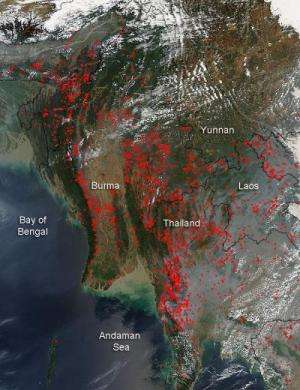Credit: NASA/Goddard, Lynn Jenner
Agricultural fires are still burning in Indochina ten days after the last NASA web posting about the fires. This natural-color image, taken on March 07, 2014, by the Moderate Resolution Imaging Spectroradiometer, MODIS, aboard the Aqua satellite, shows a more comprehensive area of burning agricultural fires that stretch from Burma through to Laos and south throughout Thailand.
Actively burning areas, detected by MODIS's thermal bands, are outlined in red.Fire is used in cropland areas for pest and weed control and to prepare fields for planting. Crop residue burning helps farmers as it is a cheap and effective method to remove excess residue. If this excess residue is not removed, future seeding is prevented by shading out the next crop and facilitating mold growth. Crop residue burning also provides a short-term ash fertilization effect.
Although this seasonal burning helps farmers with their crops, it has detrimental effects as well. Vast amounts of smoke are released into the atmosphere causing air pollution and adversely affecting health, especially to those with respiratory concerns.
Provided by NASA's Goddard Space Flight Center
























